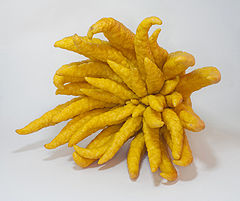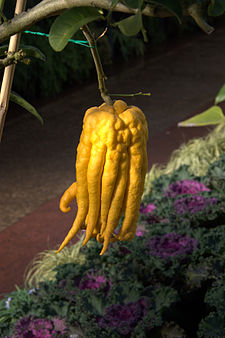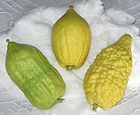- Buddha's hand
-
Buddha's hand
Citrus medica var. sarcodactylis
Buddha's hand fruit, underside of "open hand" form Scientific classification Kingdom: Plantae Division: Magnoliophyta Class: Magnoliopsida Subclass: Rosidae Order: Sapindales Family: Rutaceae Genus: Citrus Species: C. medica Variety: C. m. var. sarcodactylus Trinomial name Citrus medica var. sarcodactylus Buddha's hand, Citrus medica var. sarcodactylis (also known as bushukan (Japanese) or fingered citron), is a fragrant citron variety whose fruit is segmented into finger-like sections. The origin of Buddha's hand plant is traced back to Northeastern India or China.
Contents
Description
Citrus medica var. sarcodactylis is a shrub or small tree with long, irregular branches covered in thorns. Its large, oblong leaves are pale green and grow about four to six inches. Its white flowers are tinted purplish from the outside and grow in fragrant clusters.[1]
Buddha's hand has a thick peel and only a small amount of acidic flesh (if any) and is juiceless and sometimes seedless.
Uses
Buddha's hand fruit is very fragrant and is used predominantly by the Chinese and Japanese for perfuming rooms and personal items, such as clothing.
The fruit may be given as a religious offering in Buddhist temples. According to tradition, Buddha prefers the "fingers" of the fruit to be in a position where they resemble a closed rather than open hand, as closed hands symbolize to Buddha the act of prayer.
Culinary
Acidic-pulp varieties: Non-acidic varieties: Pulpless varieties: - Buddha's hand
- Yemenite citron
Related Articles: Citrus • Succade • Hybrid • Grafting • Chimera • Etrog • Sukkoth • Four Species The peel of the fruit can be candied into succade. In Western cooking, it is often used for its zest. The inner white pith is not bitter as is usually the case with citrus, so the fingers may be cut off and then longitudinally sliced, peel, pith, and all, and used in salads or scattered over cooked foods such as fish.
Cultivation
Citrus medica var. sarcodactylis is cultivated for fruit crops and as an ornamental tree in gardens and containers on patios and terraces. It is sensitive to frost, as well as intense heat and drought. It grows best in temperate conditions. Areas such as the coast of Southern California as well as inland valleys are considered ideal for its planting. Trees can be grown from cuttings taken from branches two to four years old. It is very commonly grafted onto sufficient rootstock.
See also
References
- ^ "Buddha's hand citron". Catalog of the Citrus Variety Collection. Riverside, CA: University of California, Riverside, Department of Botany and Plant Sciences, Citrus Experiment Station. http://www.citrusvariety.ucr.edu/citrus/buddha.html. Retrieved 2010-04-20.
- "Citrus medica var. Buddhas Hand". Catalog of the Living Plant Collections. Storrs, CT: University of Connecticut, Department of Ecology & Evolutionary Biology, Plant Growth Facilities. http://florawww.eeb.uconn.edu/199200352.html. Retrieved 2010-04-20.
- Karp, David (Winter 1998). "Buddha's Hand Citron". Flavor and Fortune (Kings Park, NY: Institute for the Advancement of the Science and Art of Chinese Cuisine) 5 (4): 5–6. http://www.flavorandfortune.com/dataaccess/article.php?ID=162. Retrieved 2010-04-20.
- Parrish, Marlene (18 December 2003). "Buddha's Hand makes for fragrant curiosity". Pittsburgh Post-Gazette: "In the Kitchen with Suzanne Martinson". http://www.post-gazette.com/food/20031218buddhashand1218fnp5.asp. Retrieved 2010-04-20.
- "Buddha's Hand". Produce Oasis. Redmond, WA: POP Interactive. http://www.produceoasis.com/Items_folder/Fruits/buddhas-hand.asp. Retrieved 2010-04-20.
Categories:- Citrus
- Citron
- Fruits originating in Asia
- Flora of East Asia
- Flora of China
- Flora of Japan
- Garden plants of Asia
- Ornamental trees
Wikimedia Foundation. 2010.


